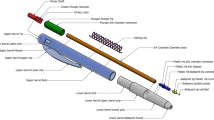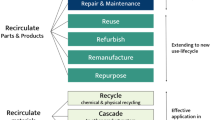Abstract
This paper presents a framework consisting of a mathematical model and an algorithm for representation, analysis and exploration of the design space in redesign problems. The framework develops and extends the existing formalism of the Characteristics Properties Model (CPM) and Property Driven Design (PDD). A platform independent quantitative model based on formal logic is presented to map the characteristics and properties, as well as the relations and dependencies between them, along with the necessary conditions for solution evaluation. The model is based on generalization of existing mathematical design models and is supported by the development of an algorithm enabling property driven design. The resulting framework offers a rich and flexible syntax and vocabulary along with a mathematical and computational tool applicable to mechanical product redesign.
Access this chapter
Tax calculation will be finalised at checkout
Purchases are for personal use only
Preview
Unable to display preview. Download preview PDF.
Similar content being viewed by others
References
Beitz, W., Pahl, G.: Engineering design: a systematic approach. Springer (2007)
Weber, C.: Looking at “DFX” and “Product Maturity” from the Perspective of a New Approach to Modelling Product and Product Development Processes. In: Proceedings of the 17th CIRP Design Conference, pp. 85–104 (2007)
Weber, C.: An Extended Theoretical Approach to Modelling Products and Product Development Processes. In: Bley, H., Jansen, H., Krause, F.-L., Shpitalni, M. (eds.) Proceedings of the 2nd German-Israeli Symposium on Advances in Methods and Systems for Development of Products and Processes, Berlin, pp. 159–179 (2005)
Köhler, C., Jan, C., Weber, C.: A Matrix Representation of the CPM/PDD Approach as a Means for Change Impact Analysis. In: Proceedings of International Design Conference, DESIGN 2008 (2008)
Yvars, P.A., Lafon, P., Zimmer, L.: Optimization of mechanical system: contribution of constraint satisfaction method. In: International Conference on Computers & Industrial Engineering, CIE 2009, pp. 1379–1384. IEEE (2009)
Scaravetti, D., Sebastian, P.: Design space exploration in embodiment design: an application to the design of aircraft air conditioners. International Journal of Product Development 9, 292 (2009)
Sébastian, P., Chenouard, R., Nadeau, J.-P., Fischer, X.: The embodiment design constraint satisfaction problem of the BOOTSTRAP facing interval analysis and genetic algorithm based decision support tools. International Journal on Interactive Design and Manufacturing (IJIDeM) 1, 99–106 (2007)
Thornton, Anna, C.: Variation Risk Management: Focusing Quality Improvements in Product Development and Production (2003) 978-0-471-44679-8
Dantan, J.-Y., Mathieu, L., Ballu, A., Martin, P.: Tolerance synthesis: quantifier notion and virtual boundary. Computer-Aided Design. 37, 231–240 (2005)
Scott, M.J., Antonsson, E.K.: Using indifference points in engineering decisions. In: 11th International Conference on Design Theory and Methodology, p. DETC2000/DTM-14559. ASME, Baltimore (2000)
Author information
Authors and Affiliations
Corresponding author
Editor information
Editors and Affiliations
Rights and permissions
Copyright information
© 2013 Springer-Verlag Berlin Heidelberg
About this paper
Cite this paper
Qureshi, A.J., Eisenbart, B., Dantan, JY., Blessing, L. (2013). Design Automation with the Characteristics Properties Model and Property Driven Design for Redesign. In: Abramovici, M., Stark, R. (eds) Smart Product Engineering. Lecture Notes in Production Engineering. Springer, Berlin, Heidelberg. https://doi.org/10.1007/978-3-642-30817-8_55
Download citation
DOI: https://doi.org/10.1007/978-3-642-30817-8_55
Publisher Name: Springer, Berlin, Heidelberg
Print ISBN: 978-3-642-30816-1
Online ISBN: 978-3-642-30817-8
eBook Packages: EngineeringEngineering (R0)




